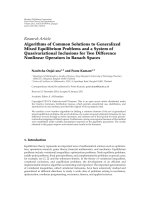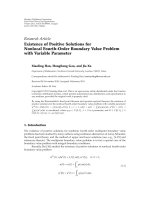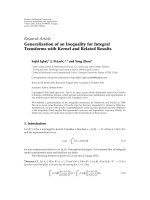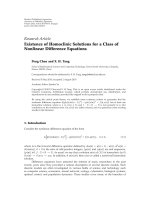Báo cáo hóa học: " Research Article Existence of Positive Solutions for Fourth-Order Three-Point Boundary Value Problems Chuanzhi Bai" potx
Bạn đang xem bản rút gọn của tài liệu. Xem và tải ngay bản đầy đủ của tài liệu tại đây (498.13 KB, 10 trang )
Hindawi Publishing Corporation
Boundary Value Problems
Volume 2007, Article ID 68758, 10 pages
doi:10.1155/2007/68758
Research Article
Existence of Positive Solutions for Fourth-Order
Three-Point Boundary Value Problems
Chuanzhi Bai
Received 11 July 2007; Accepted 7 November 2007
Recommended by Jean Mawhin
We are concerned with the nonlinear fourth-order three-point boundary value prob-
lem u
(4)
(t) = a(t) f (u(t)), 0 <t<1, u(0) = u(1) = 0, αu
(η) − βu
(η) = 0, γu
(1) +
δu
(1) = 0. By using Krasnoselskii’s fixed point theorem in a cone, we get some exis-
tence results of positive solutions.
Copyright © 2007 Chuanzhi Bai. This is an open access article distributed under the Cre-
ative Commons Attribution License, which permits unrestricted use, distribution, and
reproduction in any medium, provided the original work is properly cited.
1. Introduction
As is pointed out in [1, 2], boundary value problems for second- and higher-order differ-
ential equations play a very important role in both theory and applications. Recently, an
increasing interest in studying the existence of solutions and positive solutions to bound-
ary value problems for fourth-order differential equations is observed; see, for example,
[3–8].
In this paper, we are concerned with the existence of positive solutions for the follow-
ing fourth-order three-point boundary value problem (BVP):
u
(4)
(t) = a(t) f
u(t)
,0<t<1,
u(0)
= u(1) = 0,
αu
(η) − βu
(η) = 0, γu
(1) +δu
(1) = 0,
(1.1)
where α, β, γ,andδ are nonnegative constants satisfying αδ + βγ + αγ > 0; 0 <η<1,
a
∈ C[0,1], and f ∈ C([0,∞),[0,∞)). We use Krasnoselskii’s fixed point theorem in cones
to establish some simple criteria for the existence of at least one positive solution to BVP
(1.1). To the best of our knowledge, no paper in the literature has investigated the exis-
tence of positive solutions for BVP (1.1).
2 Boundary Value Problems
The paper is formulated as follows. In Section 2, some definitions and lemmas are
given. In Section 3, we prove some existence theorems of the positive solutions for BVP
(1.1).
2. Preliminaries and lemmas
In this section, we introduce some necessary definitions and preliminary results that will
be used to prove our main results.
First, we list the following notations and assumptions:
f
0
= lim
u→0
f (u)
u
, f
∞
= lim
u→∞
f (u)
u
. (2.1)
(H
1
) f :[0,∞)→[0,∞)iscontinuous;
(H
2
) a ∈ C[0,1], a(t) ≤ 0, for all t ∈ [0,η], a(t) ≥ 0, for all t ∈ [η,1], and a(t) ≡ 0, for
all t
∈ (p,η) ∪(η,q)(0<p<η<q<1).
By routine calculation, we easily obtain the following lemma.
Lemma 2.1. Suppose that α, β, γ, δ are nonnegative constants satisfying αδ + βγ + αγ > 0.
If h
∈ C[0,1], then the boundary value problem
v
(t) = h(t), t ∈ [0,1],
αv(η)
− βv
(η) = 0, γv(1) +δv
(1) = 0
(2.2)
has a unique solution
v(t)
=
t
η
(t − s)h(s)ds +
1
σ
1
η
α(η − t) − β
γ(1 − s)+δ
h(s)ds, (2.3)
where σ
= αδ + βγ + αγ(1 − η) > 0.
Let G(t,s) be the Green’s function of the differential equation
−u
(t) = 0, t ∈ (0,1), (2.4)
subject to the boundary condition
u(0)
= u(1) = 0. (2.5)
In particular,
G(t,s)
=
⎧
⎨
⎩
s(1 −t), 0 ≤ s ≤ t ≤ 1,
t(1
− s), 0 ≤ t<s≤ 1.
(2.6)
Chuanzhi Bai 3
It is rather straightforward that
0
≤ G(t,s) ≤ G(s,s), 0 ≤ t, s ≤ 1, (2.7)
G(t,s)
≥ mG(s,s), t ∈ [p,q], s ∈ [0,1], (2.8)
where 0 <p<q<1, and 0 <m
= min{p,1− q} < 1.
Let X be the Banach space C[0,1] endowed w ith the norm
u=max
0≤t≤1
u(t)
. (2.9)
We define the operator T : X
→X by
Tu(t)
=
1
0
G(t,s)
s
η
(τ − s)a(τ) f
u(τ)
dτ
+
1
σ
1
η
β − α(η − s)
γ(1 − τ)+δ
a(τ) f
u(τ)
dτ
ds,
(2.10)
where G(t,s)asin(2.6). From Lemma 2.1, we easily know that u(t) is a solution of the
fourth-order three-point boundary value problem (1.1)ifandonlyifu(t)isafixedpoint
of the operator T.
Define the cone K in X by
K
=
u ∈ X | u ≥ 0, min
t∈[p,q]
u(t) ≥ mu
, (2.11)
where 0 <p<η<q<1, and
0 <m
= max{p,1− q} < 1. (2.12)
Lemma 2.2. Assume that (H
1
) and (H
2
) hold. If β ≥ αη, then T : K→K is completely con-
tinuous.
Proof. For any u
∈ K,weknowfrom(2.10), (H
1
), (H
2
), and β ≥ αη that
(Tu)(t)
=
η
0
G(t,s)
η
s
(s −τ)a(τ) f
u(τ)
dτ
+
1
σ
1
η
β − α(η − s)
γ(1 − τ)+δ
a(τ) f
u(τ)
dτ
ds
+
1
η
G(t,s)
s
η
(τ − s)a(τ) f
u(τ)
dτ
+
1
σ
s
η
β − α(η − s)
γ(1 − τ)+δ
a(τ) f
u(τ)
dτ
+
1
σ
1
s
β − α(η − s)
γ(1 − τ)+δ
a(τ) f
u(τ)
dτ
ds
4 Boundary Value Problems
=
η
0
G(t,s)
η
s
(s −τ)a(τ) f
u(τ)
dτ
+
1
σ
1
η
β − α(η − s)
γ(1 − τ)+δ
a(τ) f
u(τ)
dτ
ds
+
1
η
G(t,s)
1
σ
s
η
αδ(τ − η)+βγ(1 − s)+αγ(1 − s)(τ − η)+βδ
a(τ) f
u(τ)
dτ
+
1
σ
1
s
β + α(s −η)
γ(1 − τ)+δ
a(τ) f
u(τ)
dτ
ds
≥ 0, t ∈ [0,1]. (2.13)
Hence, in view of (2.13)and(2.7), we have
Tu= max
t∈[0,1]
(Tu)(t) ≤
η
0
G(s,s)
η
s
(s −τ)a(τ) f
u(τ)
dτ
+
1
σ
1
η
β − α(η − s)
γ(1 − τ)+δ
a(τ) f
u(τ)
dτ
ds
+
1
η
G(s,s)
1
σ
s
η
αδ(τ − η)+βγ(1 − s)+αγ(1 − s)(τ − η)+βδ
a(τ) f
u(τ)
dτ
+
1
σ
1
s
β + α(s −η)
γ(1 − τ)+δ
a(τ) f
u(τ)
dτ
ds.
(2.14)
Thus from (2.8), (2.13), and (2.14), we get
min
t∈[p,q]
(Tu)(t)
≥ m
η
0
G(s,s)
η
s
(s −τ)a(τ) f
u(τ)
dτ
+
1
σ
1
η
β − α(η − s)
γ(1 − τ)+δ
a(τ) f
u(τ)
dτ
ds
+ m
1
η
G(s,s)
1
σ
s
η
αδ(τ − η)+βγ(1 − s)+αγ(1 − s)(τ − η)+βδ
a(τ) f
u(τ)
dτ
+
1
σ
1
s
β + α(s −η)
γ(1 − τ)+δ
a(τ) f
u(τ)
dτ
ds = mTu,
(2.15)
where m as in (2.12). So T : K
→K. Moreover, it is easy to check by the Arzela-Ascoli
theorem that the operator T is completely continuous.
Remark 2.3. By σ = αδ + βγ + αγ(1 − η) > 0andβ ≥ αη,wehaveβ>0.
Recently, Krasnoselskii’s theorem of cone expansion/compression type has been used
to study the existence of positive solutions of boundar y value problems in many papers;
Chuanzhi Bai 5
see, for example, Liu [7], Ma [9], Torres [10], and the references contained therein. The
following lemma (Krasnoselskii’s fixed point theorem) wil l play an important role in the
proofofourtheorem.
Lemma 2.4 [11]. Let X be a Banach space, and let K
⊂ X beaconeinX. Assume that Ω
1
, Ω
2
are open subsets of X with 0 ∈ Ω
1
, Ω
1
⊂ Ω
2
and let A : K ∩ (Ω
2
\ Ω
1
)→K be a completely
operator such that either
(i)
Au≤u, u ∈ K ∩ ∂Ω
1
and Au≥u, u ∈ K ∩ ∂Ω
2
;or
(ii)
Au≥u, u ∈ K ∩ ∂Ω
1
and Au≤u, u ∈ K ∩ ∂Ω
2
.
Then A has a fixed point in K
∩ (Ω
2
\ Ω
1
).
3. Main result
We are now in a position to present and prove our main result.
Theorem 3.1. Let β
≥ αη. Assume that (H
1
)-(H
2
) hold. If f
0
=∞and f
∞
= 0,then(1.1)
has at least a positive solution.
Proof. Since f
0
=∞,wecanchooser>0sufficiently small so that
f (u)
≥ εu for 0 ≤ u ≤ r, (3.1)
where ε satisfies
ε
≥
⎧
⎪
⎪
⎪
⎪
⎨
⎪
⎪
⎪
⎪
⎩
6
m(1 −η)
η
0
−a(τ)τ
3
dτ
,ifa
t
0
< 0, for some t
0
∈ (p,η),
σ
βmη
1
η
(τ − η)(1 − τ)
γ(1 − τ)+δ
a(τ)dτ
,ifa
t
1
> 0, for some t
1
∈ (η, q).
(3.2)
Set Ω
r
={u ∈ K |u <r}. From condition (H
2
), we consider two cases as follows.
Case 1. If a(t
0
) < 0forsomet
0
∈ (p,η), then, for u ∈ ∂Ω
r
,wehavefrom(2.13), (3.1),
and (3.2)that
(Tu)(η)
≥
η
0
G(η,s)
η
s
(s −τ)a(τ) f
u(τ)
dτ
+
1
σ
1
η
β − α(η − s)
γ(1 − τ)+δ
a(τ) f
u(τ)
dτ
ds
≥
η
0
G(η,s)
η
s
(s −τ)a(τ) f
u(τ)
dτ ds ≥ ε
η
0
G(η,s)
η
s
(s −τ)a(τ)u(τ)dτ ds
≥ mεu
η
0
G(η,s)
η
s
(s −τ)a(τ)dτ ds = mεu
η
0
a(τ)dτ
τ
0
G(η,s)(s − τ)ds
= mεu
η
0
a(τ)dτ
τ
0
(1 −η)s(s −τ)ds = mεu
1 −η
6
η
0
−a(τ)τ
3
dτ ≥u,
(3.3)
6 Boundary Value Problems
which implies
Tu≥u, ∀u ∈ ∂Ω
r
. (3.4)
Case 2. If a(t
1
) > 0forsomet
1
∈ (η,q), then, for u ∈ ∂Ω
r
,wehavefrom(2.13), (3.1),
and (3.2)that
(Tu)(η)
≥
1
η
G(η,s)
1
σ
s
η
αδ(τ − η)+βγ(1 − s)+αγ(1 − s)(τ − η)+βδ
a(τ) f
u(τ)
dτ
+
1
σ
1
s
β + α(s −η)
γ(1 − τ)+δ
a(τ) f
u(τ)
dτ
ds
≥
1
σ
1
η
G(η,s)
1
s
β + α(s −η)
γ(1 − τ)+δ
a(τ) f
u(τ)
dτ ds
≥
β
σ
1
η
G(η,s)
1
s
γ(1 − τ)+δ
a(τ) f
u(τ)
dτ ds
≥
εβm
σ
u
1
η
G(η,s)ds
1
s
γ(1 − τ)+δ
a(τ)dτ
=
εβm
σ
u
1
η
γ(1 − τ)+δ
a(τ)dτ
τ
η
η(1 − s)ds
=
εβm
σ
u
1
η
η(τ − η)
1 −
1
2
(τ + η)
γ(1 − τ)+δ
a(τ)dτ
≥
εβηm
σ
u
1
η
(τ − η)(1 − τ)
γ(1 − τ)+δ
a(τ)dτ ≥u,
(3.5)
that is,
Tu≥u, ∀u ∈ ∂Ω
r
. (3.6)
Next, define a function f
∗
(v):[0,∞)→[0,∞)by
f
∗
(v) = max
0≤u≤v
f (u). (3.7)
It is easy to see that f
∗
(v)isnondecreasing.Since f
∞
= 0, we have lim
v→∞
f
∗
(v)/v = 0.
Thus, there exists R>rsuch that
f
∗
(R) ≤ θR, (3.8)
where θ satisfies
θ
1
12
η
0
−a(τ)τ
3
dτ +
1
6σ
(1 −η)σ + βδ
1 −η
2
1
η
a(τ)dτ
+
1
6σ
β + α(1 −η)
1
η
γ(1 − τ)+δ
a(τ)dτ
≤
1.
(3.9)
Chuanzhi Bai 7
Hence, we obtain
f (u)
≤ f
∗
(R) ≤ θR,0≤ u ≤ R. (3.10)
Thus from (2.14)and(3.10), for all u
∈ ∂Ω
R
,wehave
Tu≤θR
η
0
G(s,s)
η
s
(s −τ)a(τ)dτ +
1
σ
1
η
(β − αη + αs)
γ(1 − τ)+δ
a(τ)dτ
ds
+
1
η
G(s,s)
1
σ
s
η
αδ(τ − η)+βγ(1 − s)+αγ(1 − s)(τ − η)+βδ
a(τ)dτ
+
1
σ
1
s
β + α(s −η)
γ(1 − τ)+δ
a(τ)dτ
ds
≤
θR
η
0
a(τ)dτ
τ
0
s(1 −s)(s − τ)ds+
β
σ
1
η
γ(1 − τ)+δ
a(τ)dτ
η
0
s(1 −s)ds
+
1
σ
1
η
s(1 −s)ds
1
η
αδ(1 − η)+βγ(1 − η)+αγ(1 − η)
2
+ βδ
a(τ)dτ
+
1
σ
1
η
s(1 −s)ds
1
η
β + α(1 −η)
γ(1 − τ)+δ
a(τ)dτ
=
θR
1
12
η
0
−a(τ)τ
3
dτ +
β
6σ
3η
2
− 2η
3
1
η
γ(1 − τ)+δ
a(τ)dτ
+
1
6σ
(1 −η)σ + βδ
1 −3η
2
+2η
3
1
η
a(τ)dτ
+
1
6σ
β + α(1 −η)
1 −3η
2
+2η
3
1
η
γ(1 − τ)+δ
a(τ)dτ
≤
θR
1
12
η
0
−a(τ)τ
3
dτ +
1
6σ
(1 −η)σ + βδ
1 −η
2
1
η
a(τ)dτ
+
1
6σ
β + α(1 −η)
1
η
γ(1 − τ)+δ
a(τ)dτ
≤
R =u,
(3.11)
that is,
Tu≤u,foru ∈ ∂Ω
R
. (3.12)
Hence, from (3.6), (3.12), and Lemma 2.4, T has a fixed point u
∈ Ω
R
\ Ω
r
, which means
that u is a positive solution of BVP (1.1).
Theorem 3.2. Let β ≥ αη. Assume that (H
1
)-(H
2
)hold.If f
0
= 0 and f
∞
=∞,then(1.1)
has at least a positive solution.
8 Boundary Value Problems
Proof. Since f
∞
=∞,wecanchooseR
1
> 0sufficiently large so that
f (u)
≥ Au, u ≥ R
1
, (3.13)
where A satisfies
A
≥
⎧
⎪
⎪
⎪
⎪
⎪
⎨
⎪
⎪
⎪
⎪
⎪
⎩
6
m(1 −η)
η
p
−a(τ)(τ − p)
τ
2
+ τp− τp
2
dτ
,ifa
t
0
< 0, for some t
0
∈ (p,η),
σ
βmη
q
η
(τ − η)(1 − τ)
γ(1 − τ)+δ
a(τ)dτ
,ifa
t
1
> 0, for some t
1
∈ (η, q).
(3.14)
Choose
R
≥
R
1
m
, (3.15)
where m>0asin(2.12). Let u
∈ ∂Ω
R
.Sinceu(t) ≥ mu=mR ≥ R
1
for t ∈ [p,q], from
(3.13), we see that
f
u(t)
≥
Au(t) ≥ AmR, ∀t ∈ [p,q], u ∈ ∂Ω
R
. (3.16)
For u
∈ ∂Ω
R
, we consider two cases as follows.
Case 1. If a(t
0
) < 0forsomet
0
∈ (p,η), then we have from (3.3), (3.14), and (3.16)that
(Tu)(η)
≥
η
0
G(η,s)
η
s
(s −τ)a(τ) f
u(τ)
dτ ds
≥
η
p
G(η,s)
η
s
(s −τ)a(τ) f
u(τ)
dτ ds
≥ AmR
η
p
G(η,s)
η
s
(s −τ)a(τ)dτ ds
= AmR(1 − η)
p
η
a(τ)dτ
τ
p
s(s −τ)ds
=
1
6
AmR(1
− η)
p
η
−a(τ)(τ − p)
τ
2
+ τp− 2p
2
dτ
≥ R =u,
(3.17)
which implies
Tu≥u, ∀u ∈ ∂Ω
R
. (3.18)
Chuanzhi Bai 9
Case 2. If a(t
1
) > 0forsomet
1
∈ (η, q), then we have from (3.5), (3.14), and (3.16)that
(Tu)(η)
≥
β
σ
1
η
G(η,s)
1
s
γ(1 − τ)+δ
a(τ) f
u(τ)
dτ ds
≥
β
σ
q
η
G(η,s)
q
s
γ(1 − τ)+δ
a(τ) f
u(τ)
dτ ds
≥ AmR
β
σ
q
η
G(η,s)
q
s
γ(1 − τ)+δ
a(τ)dτ ds
= AmR
β
σ
q
η
γ(1 − τ)+δ
a(τ)dτ
τ
η
η(1 − s)ds
≥ AmR
βη
σ
q
η
(τ − η)(1 − τ)
γ(1 − τ)+δ
a(τ)dτ ≥ R =u,
(3.19)
which implies
Tu≥u, ∀u ∈ ∂Ω
R
. (3.20)
Since f
0
= 0,wecanchoose0<r<Rsuch that
f (u)
≤ θu,0≤ u ≤ r, (3.21)
where θ as in (3.9). For u
∈ ∂Ω
r
,wehavefrom(3.11)and(3.21)that
Tu≤θu
1
12
η
0
−a(τ)τ
3
dτ +
1
6σ
(1 −η)σ + βδ
1 −η
2
1
η
a(τ)dτ
+
1
6σ
β + α(1 −η)
1
η
γ(1 − τ)+δ
a(τ)dτ
≤
u.
(3.22)
So,
Tu≤u, u ∈ ∂Ω
r
. (3.23)
Therefore, from (3.20), (3.23), and Lemma 2.4, T hasafixedpointu
∈ Ω
R
\ Ω
r
, which
means u is a p ositive solution of BVP (1.1).
Finally, we conclude this paper with the following example.
Example 3.3. Consider the following fourth-order three-point boundary value problem:
u
(4)
(t) = sinπ(1 + 2t)u
r
(t), 0 <t<1,
u(0)
= u(1) = 0,
αu
1
2
−
βu
1
2
=
0, γu
(1) +δu
(1) = 0,
(3.24)
where 0 <r<1, α, β, γ,andδ are nonnegative constants satisfying αδ + βγ + αγ > 0and
β
≥ (1/2)α.ThenBVP(3.24) has at least one positive solution.
10 Boundary Value Problems
To see this, we will apply Theorem 3.1.Set
f (u)
= u
r
, a(t) = sinπ(1 + 2t), η =
1
2
. (3.25)
With the above functions f and a,weseethat(H
1
)and(H
2
)hold.Moreover,itiseasyto
see that
f
0
=∞, f
∞
= 0, β ≥ αη. (3.26)
The result now follows from Theorem 3.1.
Acknowledgments
This work is supported by the National Natural Science Foundation of China (10771212)
and the Natural Science Foundation of Jiangsu Education Office (06KJB110010). The
author is grateful to the referees for their valuable suggestions and comments.
References
[1] R. P. Agarwal, Focal Boundary Value problems for Differential and Difference Equations, vol. 436
of MathematicsandItsApplications, Kluwer Academic Publishers, Dordrecht, The Netherlands,
1998.
[2] D. G. Zill and M. R. Cullen, Differential Equations with Boundary-Value Problems, Brooks/Cole,
Belmont, Calif, USA, 5th edition, 2001.
[3] Z. Bai and H. Wang, “On positive solutions of some nonlinear fourth-order beam equations,”
Journal of Mathematical Analysis and Applications, vol. 270, no. 2, pp. 357–368, 2002.
[4] J. R. Graef and B. Yang, “On a nonlinear boundary value problem for fourth order equations,”
Applicable Analysis, vol. 72, no. 3–4, pp. 439–448, 1999.
[5] Z. Hao, L. Liu, and L. Debnath, “A necessary and sufficient condition for the existence of posi-
tive solutions of fourth-order singular boundary value problems,” Applied Mathemat ics Letters,
vol. 16, no. 3, pp. 279–285, 2003.
[6] F. Li, Q. Zhang, and Z. Liang, “Existence and multiplicity of solutions of a kind of fourth-order
boundary value problem,” Nonlinear Analysis: Theory, Methods & Applications,vol.62,no.5,pp.
803–816, 2005.
[7] B. Liu, “Positive solutions of fourth-order two point boundary value problems,” Applied Math-
ematics and Computation, vol. 148, no. 2, pp. 407–420, 2004.
[8] D. Yang, H. Zhu, and C. Bai, “Positive solutions for semipositone fourth-order two-point
boundary value problems,” Electronic Journal of Differential Equations, no. 16, pp. 1–8, 2007.
[9] R. Ma, “Positive solutions of fourth-order two-point boundary value problems,” Annals of Dif-
ferential Equations, vol. 15, no. 3, pp. 305–313, 1999.
[10] P. J. Torres, “Existence of one-signed periodic solutions of some second-order differential equa-
tions via a Krasnosel’skii fixed point theorem,” JournalofDifferential Equations, vol. 190, no. 2,
pp. 643–662, 2003.
[11] M. A. Krasnosel’skii, Positive Solutions of Operator Equations,P.Noordhoff, Groningen, The
Netherlands, 1964.
Chuanzhi Bai: Department of Mathematics, Huaiyin Teachers College, Huaian 223300, China
Email address:









